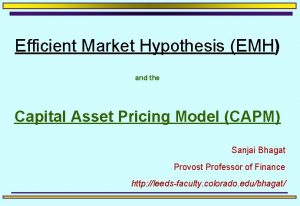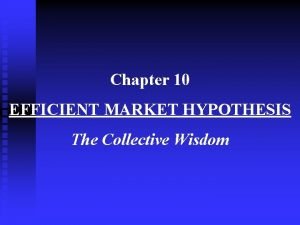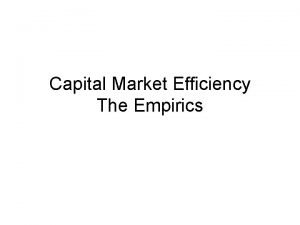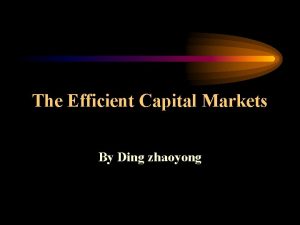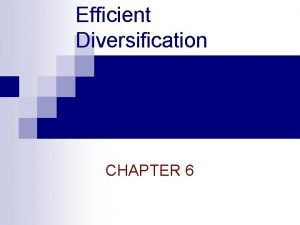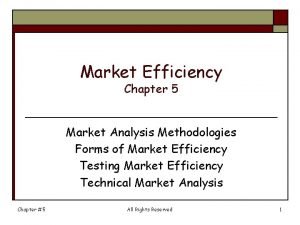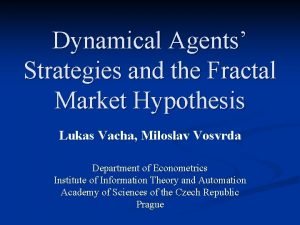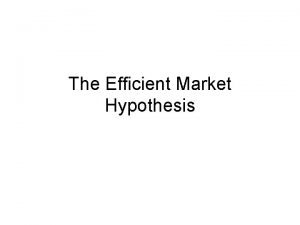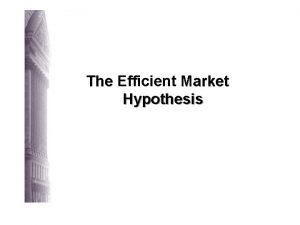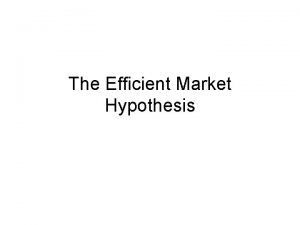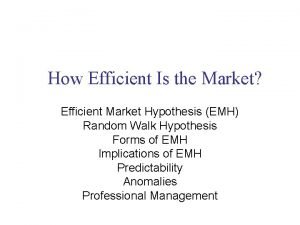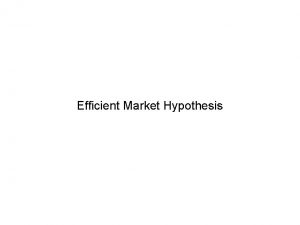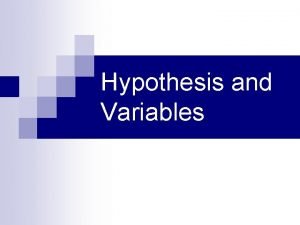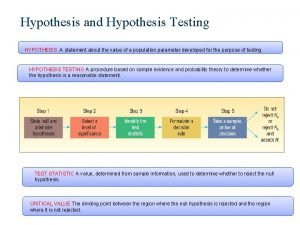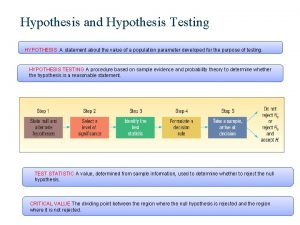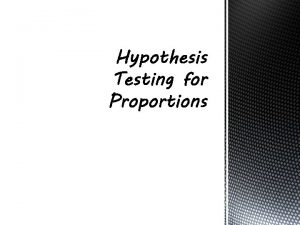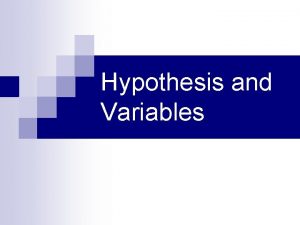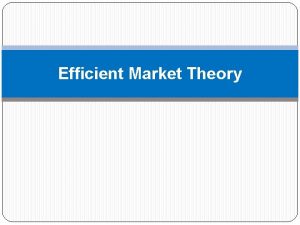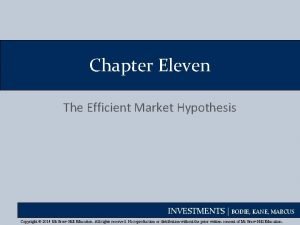CHAPTER 8 The Efficient Market Hypothesis Mc GrawHillIrwin



































- Slides: 35

CHAPTER 8 The Efficient Market Hypothesis Mc. Graw-Hill/Irwin © 2008 The Mc. Graw-Hill Companies, Inc. , All Rights Reserved.

8. 1 RANDOM WALKS AND THE EFFICIEN MARKET HYPOTHESIS 8 -2

Efficient Market Hypothesis (EMH) Do security prices reflect information Why look at market efficiency – Implications for business and corporate finance – Implications for investment 8 -3

Random Walk and the EMH Random Walk - stock prices are random – Randomly evolving stock prices are the consequence of intelligent investors competing to discover relevant information Expected price is positive over time Positive trend and random about the trend 8 -4

Random Walk with Positive Trend Security Prices Time 8 -5

Random Price Changes Why are price changes random – Prices react to information – Flow of information is random – Therefore, price changes are random 8 -6

Figure 8. 1 Cumulative Abnormal Returns Before Takeover Attempts 8 -7

Figure 8. 2 Stock Price Reaction to CNBC Reports 8 -8

EMH and Competition Stock prices fully and accurately reflect publicly available information Once information becomes available, market participants analyze it Competition assures prices reflect information 8 -9

Versions of the EMH Weak Semi-strong Strong 8 -10

8. 2 IMPLICATIONS OF THE EMH 8 -11

Types of Stock Analysis Technical Analysis - using prices and volume information to predict future prices – Weak form efficiency & technical analysis Fundamental Analysis - using economic and accounting information to predict stock prices – Semi strong form efficiency & fundamental analysis 8 -12

Implications of Efficiency for Active or Passive Management Active Management – Security analysis – Timing Passive Management – Buy and Hold – Index Funds 8 -13

The Role of Portfolio Management in an Efficient Market Even if the market is efficient a role exists for portfolio management: – Appropriate risk level – Tax considerations – Other considerations 8 -14

8. 3 ARE MARKETS EFFICIENT 8 -15

Empirical Tests of Market Efficiency Magnitude Issue – Actions of intelligent investment managers are the driving force Selection Bias Issue – The outcomes we observe have been preselected in favor of failed attempts – Cannot evaluate the true ability of portfolio managers Lucky Event Issue 8 -16

Weak-Form Tests: Patterns in Stock Returns over short horizons – Very short time horizons small magnitude of positive trends – 3 -12 month some evidence of positive momentum Returns over long horizons – pronounced negative correlation Evidence on Reversals 8 -17

Predictors of Broad Market Returns Fama and French – Aggregate returns are higher with higher dividend ratios Campbell and Shiller – Earnings yield can predict market returns Keim and Stambaugh – Bond spreads can predict market returns 8 -18

Semi-Strong Tests: Market Anomalies P/E Effect Small Firm Effect (January Effect) – Invest in low-capitalization stocks – Earn excess returns 8 -19

Figure 8. 3 Returns in Excess of Risk. Free Rate and in Excess of the SML 8 -20

Semi-Strong Tests: Market Anomalies (Con’t) Neglected Firm – Small firms tend to be neglected by large institutional traders Book-to-Market Ratios – Beta seems to have no power to explain average security returns 8 -21

Figure 8. 4 Average Annual Return as a Function of Book-to-Market 8 -22

Semi-Strong Tests: Market Anomalies (Con’t) Post-Earnings Announcement Drift – There is a large abnormal return on the earnings announcement day 8 -23

Figure 8. 5 Cumulative Abnormal Returns in Response to Earnings Announcements 8 -24

Strong-Form Tests: Inside Information The ability of insiders to trade profitability in their own stock has been documented in studies by Jaffe, Seyhun, Givoly, and Palmon SEC requires all insiders to register their trading activity 8 -25

Interpreting the Evidence Risk Premiums or market inefficiencies— disagreement here – Fama and French argue that these effects can be explained as manifestations of risk stocks with higher betas – Lakonishok, Shleifer, and Vishney argue that these effects are evidence of inefficient markets 8 -26

Figure 8. 6 Return to Style Portfolio as a Predictor of GDP Growth 8 -27

Interpreting the Evidence (Con’t) Anomalies or Data Mining – Rerun the computer database of past returns over and examine stock returns along enough dimensions: Simple chance may cause some criteria to appear to predict returns 8 -28

8. 4 MUTUAL FUND ANALYST PERFORMANCE 8 -29

Stock Market Analysts Do analysts add value—mixed evidence – Womack study found that positive changes are associated with increased stock prices of about 5% – Negative changes result in average price decreases of 11% – Are prices change due to analysts’ information or through pressure brought on by the recommendations themselves 8 -30

Mutual Fund Managers Some evidence of persistent positive and negative performance Potential measurement error for benchmark returns – Style changes – May be risk premiums Superstar phenomenon 8 -31

Figure 8. 7 Estimates of Individual Mutual Fund Alphas 8 -32

Table 8. 1 Performance of Mutual Funds Based on Three-Index Model 8 -33

Figure 8. 8 Persistence of Mutual Fund Performance 8 -34

Table 8. 2 Two-Way Table of Managers Classified by Risk-Adjusted Returns over Successive Intervals 8 -35
 Evidence supporting efficient market hypothesis
Evidence supporting efficient market hypothesis Efficient markets theory
Efficient markets theory Efficient market hypothesis
Efficient market hypothesis What is market efficiency
What is market efficiency The efficient market hypothesis suggests that _______.
The efficient market hypothesis suggests that _______. Productively efficient vs allocatively efficient
Productively efficient vs allocatively efficient Productively efficient vs allocatively efficient
Productively efficient vs allocatively efficient Productively efficient vs allocatively efficient
Productively efficient vs allocatively efficient Allocative efficiency vs productive efficiency
Allocative efficiency vs productive efficiency Productive inefficiency and allocative inefficiency
Productive inefficiency and allocative inefficiency Market follower
Market follower Bases of market segmentation
Bases of market segmentation The following are advantages of the sml approach
The following are advantages of the sml approach Characteristics of an efficient market
Characteristics of an efficient market An efficient capital market is one in which
An efficient capital market is one in which Informationally efficient
Informationally efficient Hypothesis in research
Hypothesis in research Developing null and alternative hypothesis
Developing null and alternative hypothesis Null hypothesis example
Null hypothesis example Weakness of protoplanet hypothesis
Weakness of protoplanet hypothesis Dominant capital allocation line
Dominant capital allocation line Efficient chapter 5
Efficient chapter 5 Fractal market hypothesis
Fractal market hypothesis Hát kết hợp bộ gõ cơ thể
Hát kết hợp bộ gõ cơ thể Frameset trong html5
Frameset trong html5 Bổ thể
Bổ thể Tỉ lệ cơ thể trẻ em
Tỉ lệ cơ thể trẻ em Voi kéo gỗ như thế nào
Voi kéo gỗ như thế nào Tư thế worm breton
Tư thế worm breton Chúa yêu trần thế
Chúa yêu trần thế Môn thể thao bắt đầu bằng chữ f
Môn thể thao bắt đầu bằng chữ f Thế nào là hệ số cao nhất
Thế nào là hệ số cao nhất Các châu lục và đại dương trên thế giới
Các châu lục và đại dương trên thế giới Công thức tính độ biến thiên đông lượng
Công thức tính độ biến thiên đông lượng Trời xanh đây là của chúng ta thể thơ
Trời xanh đây là của chúng ta thể thơ Mật thư anh em như thể tay chân
Mật thư anh em như thể tay chân


